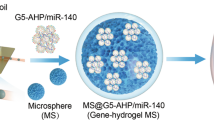Abstract
We introduce an injectable system for the formation of a biodegradable DNA-containing implant that releases DNA over a 2-month period to provide a robust and prolonged gene expression at the site. Sustained delivery of the appropriate plasmid DNA resulted in sustained expression of luciferase, the persistent appearance of secreted alkaline phosphatase in the serum and small blood vessel formation in the vicinity of the implant from the delivery of the development endothelial locus-1 gene. Local expression of development endothelial locus-1 protein promotes the development of blood vessels to meet the metabolic demands of new tissue and is a paradigm for the delivery of other growth factors that act locally to aid tissue regeneration. This delivery system involves simple preparation procedures and can be injected directly into the site, hence should be a useful approach to plasmid-based gene transfer for vaccination and tissue engineering.
This is a preview of subscription content, access via your institution
Access options
Subscribe to this journal
Receive 12 print issues and online access
$259.00 per year
only $21.58 per issue
Buy this article
- Purchase on Springer Link
- Instant access to full article PDF
Prices may be subject to local taxes which are calculated during checkout





Similar content being viewed by others
References
Langer R . Drug delivery and targeting Nature (London) 1998 392: 5–10
Luo D, Woodrow-Mumford K, Belcheva N, Saltzman WM . Controlled DNA delivery systems Pharm Res 1999 16: 1300–1308
Chasin M . Biodegradable polymers for controlled drug delivery Hollinger JO (eds); Biomedical Applications of Synthetic Biodegradable Polymers CRC Press 1995 pp 1–15
Bonadio J, Smiley E, Patil P, Goldstein S . Localized, direct plasmid gene delivery in vivo: prolonged therapy results in reproducible tissue regeneration Nat Med 1999 5: 753–759
Bonadio J . Tissue engineering via local gene delivery J Molec Med 2000 78: 303–311
Dunn RL et al. Sustained release of cisplatin in dogs from an injectable implant delivery system J Bio Comp Poly 1996 11: 286–300
Eliaz RE, Kost J . Characterization of a polymeric PLGA-injectable implant delivery system for the controlled release of proteins J Biomed Mat Res 2000 50: 388–396
Eliaz RE, Wallach D, Kost J . Delivery of soluble tumor necrosis factor receptor from in situ forming PLGA implants: in vivo Pharma Res 2000 17: 1546–1550
Royals MA et al. Biocompatibility of a biodegradable in situ forming implant system in rhesus monkeys J Biomed Mat Res 1999 45: 231–239
Shea LD, Smiley E, Bonadio J, Mooney DJ . DNA delivery from polymer matrices for tissue engineering Nat Biotechnol 1999 17: 551–554
Labhasetwar VA et al. DNA controlled-release coating for gene transfer: transfection in skeletal and cardiac muscle J Pharm Sci 1998 87: 1347–1350
Hidai C et al. Cloning and characterization of developmental endothelial locus-1: an embryonic endothelial cell protein that binds the alphavbeta3 integrin receptor Genes Dev 1998 12: 21–33
Penta K et al. Del-1 induces integrin signaling and angiogenesis by ligation of alphaVbeta3 J Biol Chem 1999 274: 11101–11109
Mao HQ et al. Chitosan-DNA nanoparticles as gene carriers: synthesis, characterization and transfection efficiency J Contr Rel 2001 70: 399–421
Truong-Le VL, August JT, Leong KW . Controlled gene delivery by DNA-gelatin nanospheres Hum Gene Ther 1998 9: 1709–1717
Mathiowitz E et al. Biologically erodable microspheres as potential oral drug delivery systems Nature 1997 386: 410–414
Roy K, Mao HQ, Huang SK, Leong KW . Oral gene delivery with chitosan-DNA nanoparticles generates immunologic protection in a murine model of peanut allergy Nat Med 1999 5: 387–391
Harris LD, Kim B-S, Mooney DJ . Open pore biodegradable matrices formed with gas foaming J Biomed Mater Res 1998 42: 396–402
Wang DQ, Robinson DR, Kwon GS, Samuel J . Encapsulation of plasmid DNA in biodegradable poly(D,L-lactic-co-glycolic acid) microspheres as a novel approach for immunogene delivery J Contr Rel 1999 57: 9–18
Choi S-J, Szoka FC . Fluorometric determination of deoxyribonuclease I activity with PicoGreen Anal Biochem 2000 281: 95–97
Uyechi LS, Gagne L, Thurston G, Szoka FC . Mechanism of lipoplex gene delivery in mouse lung: binding and internalization of fluorescent lipid and DNA components Gene Therapy 2001 8: 828–836
Tang MX, Szoka FC . The influence of polymer structure on the interactions of cationic polymers with DNA and morphology of the resulting complexes Gene Therapy 1997 4: 823–832
Barron LG, Uyechi LS, Szoka FC . Cationic lipids are essential for gene delivery mediated by intravenous administration of lipoplexes Gene Therapy 1999 6: 1179–1183
Acknowledgements
We thank Yael Eliaz for assistance with the statistical analysis, Michael Coleman and Liz Wilson for helpful comments on the manuscript and Edward Dy for technical assistance. We thank Valentis Inc. (Burlingame, CA, USA) for the gift of the plasmid DNA used in this research. We gratefully acknowledge financial support from NIH DK 46052 and the State of California Tobacco-Related Disease Research Program 8IT-0138. Dr Szoka has a financial interest in and serves as a consultant to Valentis, a biotechnology company developing gene medicines. We also thank Donald McDonald for access to the vibratome used to section the implants.
Author information
Authors and Affiliations
Rights and permissions
About this article
Cite this article
Eliaz, R., Szoka, F. Robust and prolonged gene expression from injectable polymeric implants. Gene Ther 9, 1230–1237 (2002). https://doi.org/10.1038/sj.gt.3301786
Received:
Accepted:
Published:
Issue Date:
DOI: https://doi.org/10.1038/sj.gt.3301786
Keywords
This article is cited by
-
Preparation of self-solidifying polymeric depots from PLEC-PEG-PLEC triblock copolymers as an injectable drug delivery system
Journal of Polymer Research (2012)
-
Preparation and biocompatibility study of in situ forming polymer implants in rat brains
Journal of Materials Science: Materials in Medicine (2012)
-
Lipid-based Nanoparticles for Nucleic Acid Delivery
Pharmaceutical Research (2007)



